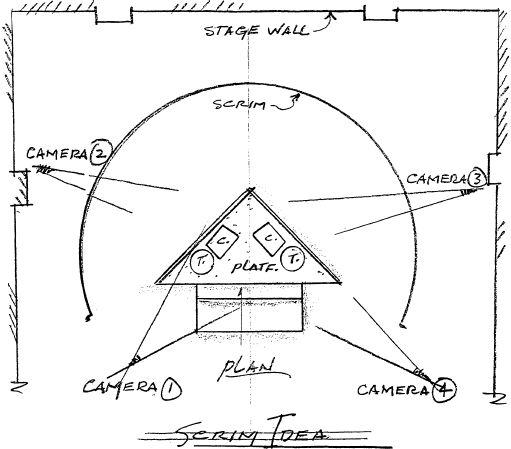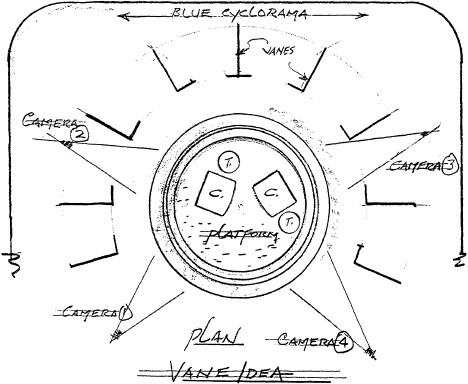The art director plays a major role in the presentation of a talk show. In the preceding chapter’s example of a drama taking place in a small town, the art director’s job was to analyze the characters and their environments, to help create the mood for the drama, and to provide the physical requirements of the action. Other types of productions, however, offer few visual clues. What forms, colors, and textures will define the space, satisfy the practical requirements, and project a mood?
Don Merton, an experienced video art director, describes some typical problems for the designer:
Many times they say they want something different, but when it comes down to it, they want to play it safe. That’s why the talk shows all look the same. You can hardly tell one from another. It’s true that the requirements are similar—a desk, a host, and an audience—but I always try to get them to do something different. Usually I can go just so far.
The producer of our talk show tells us that the host is a warm, friendly person, and that the mood of the show is to be casual and relaxed. We have some character definition and mood to work with, even though this is not a drama.
Right away, some obvious set solutions come to mind. How about the L-shaped couch, a coffee table with a plant, and bookcase walls with a fireplace? Well, that’s always acceptable and easy to shoot, and all we have to do is drag out a set of drawings made three years ago. The producer, however, has had that one pulled on her before, and she is an expert cliché-spotter.
She says, “I want to do something different. Just because the host has a friendly act going, I don’t want to see him behind a desk next to a couch and coffee table. I want to see him in a simple set that will allow the cameras to move around the set while they stay invisible. I don’t want to pay camera operators fees for on-camera appearances.” Here we thought this was going to be Talk Show 1-A and that we could design it between coffee break and lunch.
This Is Going to Mean Real Work
“Tell me more,” you say. “You want the cameras to move anywhere while they’re invisible?” This producer talks as though she believes we are magicians instead of art directors.
She goes on, “I am looking for an arrangement that will allow the host and guest to be undisturbed by the mechanics of the show. I want them to be able to carry on an absorbing conversation, undistracted by studio activity. The viewer will be an eavesdropper. We’re going to fade in on a conversation in progress. The host is not going to turn to the camera and say, ‘Hi! I’m Larry Garralous!’”
Well – a different idea at last. The couch, coffee table, and bookcase flats will stay asleep in the warehouse and we will have to put our creative brains in high gear.
To begin to solve the problem we ask, “What are the basic elements?” and discuss how to proceed. Two seated people, hidden cameras, and a background. When two people talk, they usually face each other. If the camera sees them side-by-side, they will be in profile, constantly turning their heads. The cameras have to get straight on to the two faces, but if they do that, are the cameras going to see each other? Yes, they will, but if we set the two people at a slight angle to each other, head-turning will be minimized. Better still, we will figure out a way they can face each other.
THE GREAT CHAIR SEARCH AND THE PROPER HEIGHT
What kind of chairs? The chairs’ design should prevent slouching and make the sitter appear to have good posture. The seats and backs should be firm so that the sitter does not sink in and appear to be part of the upholstery. The backs of chairs should be covered by the sitter so that the sitter does not appear to have sprouted wings, and the chairs’ height needs to prevent sprawling.
Upholstered dining armchairs usually look good on camera because they satisfy the requirements. Avoid swivel chairs unless the talent can sit still. When a nervous guest swivels, viewers can become seasick. Avoid using high director’s chairs because on wide shots, the occupants appear to be sitting on perches.
Seating on the Upper Platform Only
Because the four cameras to be used on this program will not be mounted on cranes or low dollies and cannot get down to the eye levels of the host and guest, the cameras will be forced to look down at the show participants if their chairs are on the stage floor. We will bring the seating up to eye level with a platform.
Platforms do not have to be boring rectangles. Remember that platforms become part of the set design on wide shots, and that they can be an interesting combination of shapes and colors. Depending on the height of the platform, a wide step or steps with at least 12-inch wide treads adds design interest as well as helping guests get up there. Allow at least a 4’ x 4’ space for each seated person. Instrumental groups require special attention, because different instruments need different amounts of space and, in some cases such as drum sets, special floor treatment.
Now that we have taken care of the chair and platform parts of the set, the most difficult problem faces us: the invisible cameras. How are we going to hide them if they are going to freely roam the set? The director, of course, can block the cameras so that they do not see each other, but we can be helpful by figuring out ways to let them hide while allowing the lenses free access.
One way would be to use a black cyclorama all the way around the stage walls and have the cameras using zoom lenses work as far away from the platform area as possible. Using this idea, the cameras might have to be draped in black cloth. This approach, however, will leave our fascinating conversation sitting in a black void.
We can do research for a talk-show set in the same way we did for the Iowa pilot. Architectural and home decoration magazines are full of forms and materials that, when viewed as abstract shapes, can be developed into set pieces. The three basic shapes – circle, square, and triangle – are the design foundation of everything we see and can be put together in countless ways, as you will see by analyzing architectural designs.
Scrim Shot
In one of the magazines, we see some tall, sheer drapery fabric hanging behind the front windows of a bank building. Because the light level outside the building is higher than that inside the building, the curtains are opaque from the outside and transparent from the inside.
To ape the bank building drapery, we could hang a stretched scrim (gauze fabric) from the grid to the stage floor, eight feet or more from the stage walls, going around three sides of the stage. If the scrim is a light color, it will reflect ambient light from the set lighting, or can be patterned with shafts of light, for example. The cameras working behind the scrim will look through the fabric and be hidden from the set side. This approach needs some experimentation to see if the scrim will diffuse the photography too much.

Another magazine picture shows some tall, vertical sunlight-control vanes outside a building window. When viewed from one angle, the group of vanes appears to be a solid wall. Another more straight-on view reveals what is beyond the spaces between the blinds. We could design some four-foot-wide vertical flats similar to those in the picture, which would hide the cameras and, from many angles, allow the camera lenses free rein to the set. A simple white model of this design would help the director see this set’s possibilities.

It’s always a pleasure to work with producers and directors who are not willing to settle for obvious solutions, but we must be willing to accept failure too. Maybe a design doesn’t work today, but improved technology may let you bring it out of storage later. There are no ideal solutions. All designs have drawbacks, but your choices are unlimited. Good ideas come from unexpected places—we once saw a production designer turn a piece of gutter trash into a planet’s surface. Above all, keep your eyes open.
•
Imaginative solutions can be applied to other forms of programming as well In the next chapter we will see how the art director works out several solutions for a news set and see how they are received.
